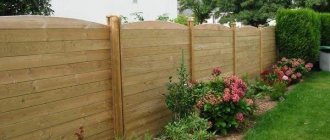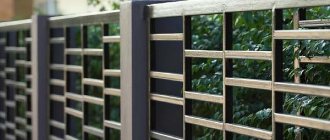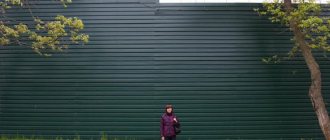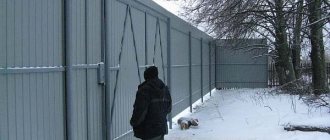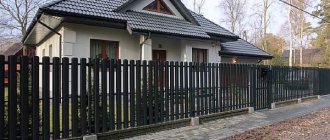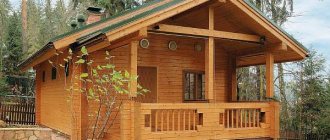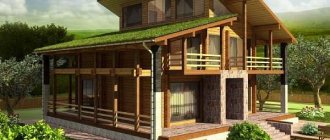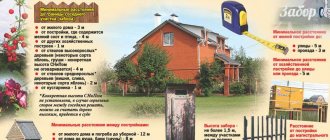The height of the fence is a standard clearly defined in SNiP 30-02-97*. Its new edition was adopted in 2021. This is SP 53.13330.2019. Compliance with the standards is mandatory in individual housing construction plots according to the law for 2020-2021, and in other types of land ownership - summer cottages, SNT, private household plots and in populated areas. But there are nuances that determine how high the fence between neighbors should be, as well as the material it is made of, and the existence of a mutual notarized agreement. They allow you to install a fence with deviations from accepted rules.
In a private house
Basic documentation
Note that restrictions on the height of the fence on the street side were not officially adopted. This should not be forgotten. The maximum permissible height is determined by municipal or local authorities, but for the façade of a private house, according to the law of the Russian Federation, no specific parameter is provided. A very high fence can be installed from the street even in SNT, when neighbors and the management of the non-profit association have no complaints about this.
Fence between neighbors in a village
Basic requirements for a fence on the site:
- According to the current law, land allotment must be limited to the extent confirmed by ownership documents from an authorized cadastral institution with a state license. And even at the dacha, according to the law, the boundaries of the site are marked by a fence.
- Federal standards established in SNiP apply only to the standard that determines how high a fence can be installed between neighbors. The need to designate the optimal parameter arose to prevent numerous disagreements and disputes. By observing this parameter, you can prevent violation of the rights of owners on either side of the fence.
- According to GOST, it should not contain damaging elements that could cause damage to passers-by, children, neighbors, or the family of the owner of the plot.
- Officially determined, the height of the fence between neighboring plots by law should not exceed the required level in order to prevent darkening of the garden, lack of aeration and other unpleasant aspects that may result in complaints and demands or height restrictions.
- A fence higher than SNiP (SP) norms is acceptable if the fence has the necessary transparency for light and air, but at the same time achieves its intended purpose - it closes the area from prying eyes. It does not matter whether the fence is built of brick or wood. Using both materials, it is possible to build in such a way that the requirement of permeability is maintained, and the neighboring plot does not suffer.
High fence in the city
The SNiP collection, adopted since 2010 as a legislative argument in legal disputes, or the GOST, compiled long ago, which has not lost any relevance - all these are methodological guidelines for determining the maximum height of a fence in accordance with the standards.
To correctly determine the maximum permissible parameters of the front part of the fence, it is better to consult with a competent lawyer who deals with such issues. He is also aware of the restrictive regulations existing by the regional authorities.
In order to install a fence between areas, you need to refer to SP 30-102-99 or rely on SP 53.13330.2019.
But the latter, even with adjustments, is not responsible for what the fence between neighbors should be according to the law in 2020-2021, where the vertical size is determined only on dacha plots.
In Moscow, St. Petersburg or any other city, you will need the Town Planning Code or instructions from city authorities; the height of the fence between neighbors in a private house depends on the instructions of local or regional norms and requirements. In SNT, this issue may be determined by the charter of the gardening partnership.
Read: Distance from garbage containers to a residential building: SNiP, SanPiN standards from garbage cans
Need to pay attention
Earlier, in 2021, amendments to SP 53.13330.2011 were adopted, according to which the height of the fence in a dacha cooperative between neighboring private houses and plots cannot exceed 1.5 meters, and the material can only be chain-link mesh.
Country houses
But no one prohibits construction at a dacha with other parameters if a written agreement is reached with the neighbor and the administration is notified about this. In 2021, this situation remains the same and no new standards have been adopted.
Ways to resolve disputes with neighbors
Most often, disagreements arise between neighbors regarding the size of the plot. Everyone is trying to increase their own territory. Sometimes this happens by installing a fence outside your property. To avoid such situations, you should draw up a contract or agreement where all the nuances will be fixed.
This will allow:
- initially clarify all controversial issues;
- have a document that has legal force and is evidence in court;
- stipulate all the consequences of non-compliance with the agreement.
If neighbors refuse to sign this, it is better not to risk it and adhere to the recommendations of SNiP. Otherwise, it will be impossible to prove the existence of an oral agreement in court. If the neighbors did not install the fence according to the rules, and attempts to resolve the situation peacefully did not yield results, you can safely go to court.
However, do not expect the trial to be simple. Determining who is right and who is wrong depends on a large number of factors.
There are issues whose solutions are not described in the legislation.
For example, there are no clear guidelines on who should install the fence between properties. Land owners do this at their own request and discretion. Mutual installation of fencing is also allowed by prior agreement.
The video talks about the standard distances from the fence to the courtyard buildings.
Standards for fence
The legislation on development in 2011 was supplemented by a decree according to which even the maximum height of 150 cm (the generally accepted norm) is not considered legal if the rule of opacity to air or light is violated. It also applies to individual housing construction (private sector), but deviations may again be allowed if the other party to the agreement has no objections and is ready to confirm its consent in writing.
At the same time, the front fence does not have such restrictions; its maximum height is not limited in order to protect the household from attacks by intruders from a city street or driveway in the village.
But it is necessary to take into account that:
- GOST has long determined the requirements for a fence according to the material of manufacture (brick or corrugated board), safety precautions when working at height, as well as taking precautions when working with different types of building materials;
- the main purpose determines the placement of part of the fence - on the facade, between plots, on the back side or along the road, the location of the house on the edge of a populated area;
- 5 meters is the most optimal parameter for a perimeter fence - it allows you to jump over and climb over in case of emergency, but protects access to your neighbor’s land under normal conditions;
- one of the main points is the territorial affiliation of the land plot (the charters of partnerships or dacha cooperatives may allow deviations from the norms);
- the height may be prohibited or permitted on the basis of sanitary and hygienic, fire safety rules or public safety standards.
Permissible fence height according to the law and SNiP standards in 2021
As a rule, the installation of a fence can be determined by the terrain (non-standard slope, windy side, requiring additional protective measures during installation) or the characteristics of the climatic zone. This is especially true for the now popular profiled sheet, which can give a sailing effect and create an additional threat of destruction (and therefore a danger to others).
We must not forget that federal laws do not establish the maximum permissible height of a street fence, provided that safety regulations are followed. The only thing that needs to be observed in an individual structure is the distance from the gate or gate to the roadway of at least 2 meters 50 centimeters. Otherwise, you need to build in such a way that the opening occurs inward, onto the local area.
How to write?
Before you begin drawing up a conciliation document, you should consider the following recommendations for its preparation:
- It must be in writing (printed or handwritten) and cannot be considered provided only from the words of neighbors.
- It is provided only by owners of neighboring plots whose interests may be affected by the construction of a fence. It cannot be issued on behalf of their family members, tenants or persons occupying the territory on other grounds.
- Accurate information about the construction initiator, his neighbors, and the land plots themselves is indicated, which will allow them to be easily identified if necessary.
- The date corresponding directly to the date of preparation or signing is indicated.
- It is secured by the personal signatures of all persons indicated in the document.
To give the document greater legal weight, it is recommended to have the signatures certified by a notary. In this case, the neighbor will have no reason to retract his words (for example, to claim a forged signature or come up with other excuses).
Contents of the document
The current legislation does not provide for a specific form and requirements for the content of consent from neighbors. However, the document should include the following information:
- Full name, passport details of the owners.
- Addresses of each site.
- Documents confirming the parties' ownership of real estate.
- The fact that neighbors consent to the construction of a fence, indicating its location and specific parameters.
- Additional conditions (for example, sharing the costs of installing fences, etc.)
- Details of witnesses (if they are present when signing the document).
- Date of compilation and personal signatures of all parties present with a transcript.
Requirements of the law and norms of SNiP (SP)
Most citizens of the Russian Federation either own individual land plots of various forms of ownership, or save money to acquire them. According to today's legislation, every owner must build a fence to mark the boundaries of his land. Therefore, it is necessary to install street barriers.
Indentations from the fence on the individual housing construction site according to the law in 2020-2021
The main document for compliance with fence construction standards is considered to be SP 53.13330.2011 (SNiP 30-02-97 as amended), to which some adjustments were made in 2021.
Therefore, now you need to be guided by an even newer edition, which determines what the maximum height of the fence at the boundary between neighboring plots should be according to the law.
Although neither the old nor the new edition of the joint venture indicates how many meters will be considered legal when constructing the front part of the fence or the back part, facing another street or driveway, if the site is located end-to-end.
Long-term construction practice indicates that the absence of restrictions at the federal level does not mean that there are no defining documents at the territorial level. Meanwhile, failure to comply with current standards risks administrative liability or even criminal liability, depending on what law was violated by the owner.
Wooden fence on a private plot
We must not forget that the Law of the Russian Federation in 2021 regulates the parameters of the fence only in some cases. These include:
- personal subsidiary plots (PHS), where it is allowed to grow crops and breed birds and livestock;
- gardening non-profit partnerships (SNT), which may have additional requirements for the appearance and height of fences facing the street;
- dacha partnerships that do not have a commercial background (so-called dacha cooperatives).
Read: At what distance from the fence can a garage be built: SNiP standards and the 2021 law in SNT and individual housing construction
Height requirements for gates and posts
When selecting the height of the supports, it is important to remember that they are buried in the soil lower than the freezing point of the soil. The average is 1.2–1.5 m, but it differs depending on the material:
- For a chain-link, a depth of 0.5 m is sufficient with an above-ground height of 1.2 m.
- For corrugated sheeting, the total height is 3 m. The above-ground part is 1.8 m.
- When creating brick and concrete fences, it is worth considering the thickness of the masonry. When the height of the structure is 3 m, the masonry is laid with 2 bricks, up to 3 m - with 1.5 bricks.
The gate must be flush with the sections. Any deviations in height will give an unsightly appearance to the entire structure.
The more massive the gate, the greater the load it puts on the foundation, so it is important to think about the type of foundation in advance.
If you want to highlight a gate with a wicket against the general background, then it would be right to decorate it with artistic forging.
Features of legislation
However, even according to the federal laws of the Russian Federation in 2021, there are no height restrictions for the construction of a street fence. To build a high barrier against intruders, you will not need permission to build a part overlooking a quarry or ravine. By the way, the law does not prohibit leaving hard-to-reach areas without a fence, from which access to the site is difficult due to the terrain.
Fence between neighbors in the country
The basic requirements for the construction of a barrier from the street, described in the standards, are conditional in nature - not to pose a threat to others and not to interfere with ventilation and lighting.
But since there are no standards for ventilation and illumination of public areas (at least not yet), it is very difficult to prove in a lawsuit that excessive height interferes with anything.
One way or another, in the private sector, when building a townhouse or cottage in an urban environment, restrictions adopted by city authorities or the Town Planning Code may become an obstacle.
It should be noted that the standard level of street fences is a common occurrence in an urban village or in an SNT (garden partnership). But if, after consulting with a lawyer, it turns out that the individual housing construction is located in a rural area where there are no regulations, the height requirements will be determined by other factors.
First of all, there must be a strip foundation for the fence, if a euro-picket fence or corrugated sheet is used (this also applies to heavy metal fences), the fire safety of the building, and the strength of the pillars used in the installation of the fence.
The photo below shows the fence of a private house in the village.
Fence between neighbors on a private housing plot
As a rule, experts advise limiting the height to no more than 2.2–2.5 meters. It is optimal if the owner of the land needs to limit access to any type of local area, prevent entry into it through a fence, or limit access to the garden with fruits.
In the latter case, it must be taken into account that the distance to a high tree from the fence should be at least 4 meters. And even if there are no restrictions, it is better to focus on the height of the neighbors’ fence. Otherwise, neighbors will be able to file more than one lawsuit.
Consequences of missing a document
Neighbors who consider that the fence between plots does not meet the requirements in terms of height, transparency, location (if any are prescribed in local regulations) may demand:
- Bringing to administrative responsibility and issuing orders from local authorities to eliminate discrepancies in height, transparency or other violations.
- Demolition of the fence in court. The basis for action will be the provisions of Art. 304 of the Civil Code of the Russian Federation, if it can be proven that the presence of a fence violates legal rights and interests (restricts the cultivation of crops due to shading, is located on someone else’s territory).
If you cannot reach an agreement with your neighbors peacefully, it is better to turn to lawyers for help in further actions. They will help you competently file a claim in court, the decision of which will be the legal basis for installing the planned fence.
When choosing the type and location of a fence for your site, you need to take into account not only personal preferences, fire and sanitary standards, but also coordinate its characteristics with the owners of neighboring sites.
How to obtain consent? What language should be used in the document? Our site’s lawyers are ready to answer these and other questions during a free consultation. Attention!
- Due to frequent changes in legislation, information sometimes becomes outdated faster than we can update it on the website.
- All cases are very individual and depend on many factors. Basic information does not guarantee a solution to your specific problems.
That's why FREE expert consultants work for you around the clock!
- via the form (below), or via online chat
- Call the hotline:
- Moscow and the Region
- St. Petersburg and region
- FREE for a lawyer!
By submitting data you agree to the Consent to PD Processing, PD Processing Policy and User Agreement.
Anonymously
Information about you will not be disclosed
Fast
Fill out the form and a lawyer will contact you within 5 minutes
Tell your friends
Rate ( 1 ratings, average: 5.00 out of 5)
How to build a fence between plots
Let us immediately emphasize that the new federal law on fences provides additional conditions for delimiting small areas. In the previous edition, it was still possible to build a fence that was permeable to air and light, while avoiding any complaints.
Standards for the location of buildings on sites in SNT and individual housing construction according to SNiP (SP) and SanPiN in 2020-2021
Today, in the law discussed by legislators since 2021, there are no discrepancies in the understanding of height - one and a half meters, or even better - a meter, and the structure must certainly be mesh. Fencing cannot be installed higher without proper approvals.
This is caused not only by the need to comply with housing standards in very limited areas, but also by fire requirements and rules. The main method recommended in such cases is to reach a mutual agreement with a neighbor. All this applies to the Moscow and Leningrad regions (MO and LO), Moscow, St. Petersburg and all other regions of Russia, be it cities, villages or rural settlements.
Read: Distance from the septic tank to the fence: SNiP and SanPiN standards from the border of the neighbor’s property
But if the relationship doesn’t work out, you shouldn’t despair; there are several other methods for creating a solid fence:
- you can install a mesh structure of the required height and make it impenetrable to prying eyes (the Internet is replete with similar methods - from embroidery with old threads to camouflage mesh and threading plastic slats);
- note that, moving away from the demarcation boundary exactly one meter (but not a centimeter less), you can build a fence of any configuration and degree of impenetrability (the ban on a solid fence only applies to one that runs exactly along the demarcation boundary, but on your own site you can do the same) ;
- establish at least one hive on the site - bees are subject to the apiary law, and this makes it possible to build a structure of the required height;
- resort to constructing a low solid fence, and build up the rest of the part with transparent material that transmits light and reflects prying eyes (such materials are already on sale, but this is not a cheap pleasure).
Moreover, the last technique has been tested several times, and there is documentary evidence of this. Low, meter high, installed on the boundary, this is a signal one. With its help, you can insure yourself against bad neighbors if they decide to seize what they think is free territory.
Below is a video on this topic.
Height limits depending on material
It is important to remember that the height of the fence is directly proportional to the length of the estate. Therefore, you should not build high walls around a small summer cottage.
In addition, the growth rate of plants and trees planted near the fence depends on the transparency of the structure.
Let's look at recommendations regarding the height of a fence between neighbors made from different materials.
Chainlink
Metal grid. Produced in rolls 10 m long and 1.5 m wide. You can individually order a chain link of greater length.
Read the article: “How to build a chain-link fence”
An excellent option for delineating the boundaries of a summer cottage. It allows light and air to pass through well and will not be an obstacle to normal plant growth.
There are no special height restrictions. Recommended for installation around fruit plantings and front gardens.
Corrugated sheet
The optimal height is 1.5–2 m. But the larger the area of the fence, the more the load on the foundation will increase.
Article to read: “Wood-like corrugated sheet fencing”
For houses with a large territory, it is worth taking a metal profile as pillars, and a monolithic strip for the foundation.
Profiled sheets do not allow light or air to pass through, so when installing on the border with a neighboring property, it is better to obtain the consent of its owners in advance.
Brick, concrete
Fences made of solid materials should be installed on the street side. If you decide to put a reliable brick fence around the entire house, then you need to build it at a distance of 1 m towards your estate.
The optimal height is 1.5–2 m (the exact figure depends on the region). A larger figure is allowed for fencing construction sites.
A solid fence does not allow light or air to pass through. Therefore, planting low-growing plants nearby is unacceptable.
Article on the topic: “How to make a brick fence”
Combining stone, brick or concrete panels with other materials is another matter.
Brick pillars with a base look beautiful in combination with forged or polycarbonate spans.
Prefabricated concrete panels called Eurofence are inexpensive. They do not need finishing and provide the necessary air exchange and access of light to the territory. If you wish, you can order the installation of such a turnkey structure from any construction company.
Euro picket fence
The recommended height is 1.8 m. This is a good option for both street and fencing between areas. Material – metal. The shape resembles a standard wooden picket fence. It is attached with gaps, thereby ensuring good passage of air and light. Installation is simple, so you can do it yourself.
When looking for a budget material for fencing a private property, preference should be given to mesh. If you want a reliable and beautiful structure, then prefabricated concrete panels or a European picket fence are best suited.
Users often search for:
- Construction of a wooden picket fence
- Metal picket fence
What else to pay attention to
Note that if you keep all payment documents from the company that will supply building materials and take photographs of the second blind fence, which is everywhere at least a meter apart, the court upholds its construction. Disputes may arise over the fact that the fence damages the plantings in the neighbor's garden. In this case, you can demand an examination - it is not cheap, and the neighbors will pay for it - the losing party is guaranteed.
Often, the need to build a blind fence arises from constant grassing of plantings by neighbor's livestock, walks by a dog that has chosen someone else's garden as a hunting ground. If pets are large, then it will not be difficult for them to jump over a low fence. True, cats can also penetrate through the roof, where they get through the balcony, but this is no longer so dangerous for crops.
The photo shows a high neighbor's hedge.
Fencing between plots in a private house
Sample
The agreement must include the following information:
- details of the parties (full name, passport details, registration address);
- information about rights to a land plot (details of the title document and extracts from the Unified State Register of Real Estate);
- address and area of the site;
- cadastral numbers of plots;
- description of the fence (height, density, location);
- cost of making a fence;
- procedure for distribution of expenses;
- data on the consent of the parties to the installation;
- signatures of the parties.
Sample agreement between neighbors to install a fence
